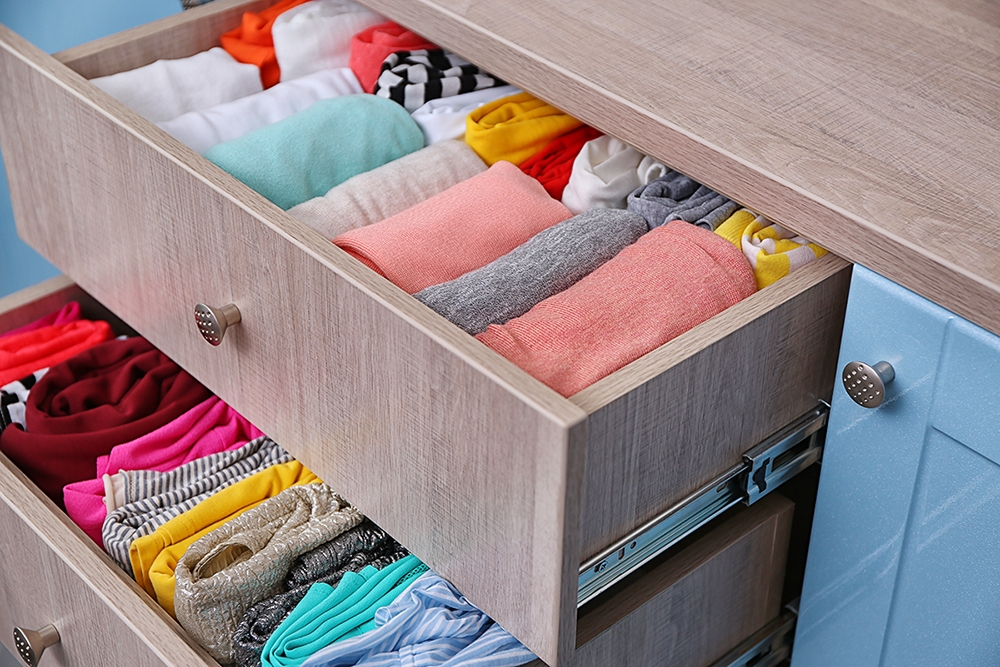
The sun is out and the breeze is cool, which seems it’s finally and officially spring. If you’re getting ready to pull out your warm weather clothes or prepping for your annual garage sale, take a look at some spring cleaning tips and tricks from Baltimore’s professional organizer, Amy Bloomer.
A Four-Step Approach
Stage One: Discovery & Distribution
Start small and get digging. “It’s the most difficult phase because you have to face your stuff, so I like to frame it as a discovery process—let’s be excited about what we’re going to find instead of horrified.” To ease up the intimidation, tackle a smaller, more confined space to build up the confidence to take on the abyss that you may call a garage. Then, distribute your discoveries into piles based on similarity rather than sorting to purge.
Stage Two: Decision Making
Once you’ve gathered and categorized, it’s time to make some decisions. But, don’t worry. Bloomer’s discover and distribution stage leads to easy decision making through the power of aggregation. “Instead of making a decision 50 times every time, when you throw everything in a pile and aggregate, it makes it easier to say, ‘Wow, ok do I really need all these scissors in my life?” Yet, don’t feel pressured to throw out everything and anything. “I really want people to be able to keep everything they feel that they need. Having said that, in order to transform a space there has to be a change in the number of things in that space.” Take that doorstep stash of shoes to the donation center or find them a new home on a shoe rack.
Stage Three: Determine a Zip Code
With everything out in the open, it’s time to get down to the real business—developing an organizational system. “Determining a spatial zip code is when you’re creating a system that is going to make life easier and more efficient for you,” Bloomer explains. “When you’re making a cup of coffee in the morning, do you have all of the things to make the cup: beans, coffee filters, a water source, coffee cup, and fixings all in one place or do you have them in five different places in the kitchen, making it five times as long to make?”
Stage Four: Dedication
The most simple, but perhaps the most difficult step is committing. You can spend hours discovering and distributing, but if you let the mess spill over a month or two later, you’ll find yourself back at stage one by next spring. So, create boundaries for yourself. For Bloomer, a simple rule is keeping a basket at the bottom of her stairs, “anything that kind of gravitates to the first floor that shouldn’t, I put into the basket and then at night I take five minutes, bring the basket upstairs, and I put the stuff back where it belongs.” Something just as quick and simple can keep the everyday mess under control.
Home
On Shared Spaces: Begin in spaces you have most control over, like your own bedroom. The more people that operate in a space, the more chaotic and difficult it can be to find a system that works.
On Living Spaces: It’s time to recycle those holiday catalogs! Always recycle as much as you can and look into transferring from paper to digital subscriptions to clear up the clutter and resist temptation.
On Bathrooms: It may be time for a linen refresh! Towels and wash cloths are used too regularly to neglect. The springtime is a perfect time to re-evaluate the condition of your bathroom linens. And instead of tossing old towels in the trash, Bloomer suggests donating them to zoos and pet rescues.
On Bedrooms: We often forget about our bedding, but this cozy oasis can harbor a collection of bacteria and dust mites. Take the time to wash you pillows every three to six months and invest in a mattress cover.
On Kitchens: The change of season is a good time to re-evaluate a lot of things, especially your pantry. Be sure to get rid of any expired foods and define an organizational rule like grouping grains with grains and sauces with sauces. Also, take a look at your kitchen sponge! This is another hub for bacteria that we sometimes don’t notice. Bloomer advises washing your sponge in the dishwasher or microwave once a week.
Clothes
On Hanging & Folding: Don’t labor over the KonMari folding method if it’s taking up more time and energy. Try different folding methods such as “Bloomer Bundling” or save space and take more delicate care of your clothing with felt hangers.
On Shared Closet Space: Like any shared space, it’s critical to designate areas that are your own. Compromise on ways to hang and store items so that all parties are able to easily visualize and access most items.
Car
On Trunks: Amy suggests this easy rule: Anything that isn’t a passenger in the car should be stored in the trunk. Keep your trunk spic and span with a trunk organizer and stay dedicated to keeping it from overflowing.
On Aux Cords & Car Chargers: There are many products out there, but twist ties are sturdy and simple. Roll cords together and place a twist tie to keep them from tangling or unraveling. Use different colored ties to differentiate cords.
Office
On Filing: Believe it or not, most files can likely be stored digitally. No need for large filing cabinets or multiple filing folders. Identify a boundary for yourself, such as keeping an inbox tray that you clear out weekly.
